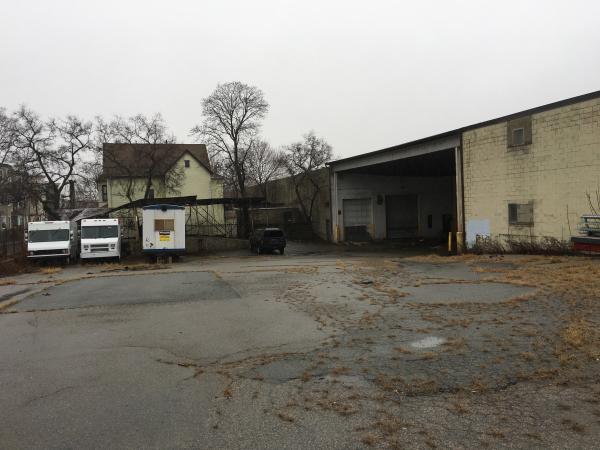February 25, 2016

A breaking and entering into this Hancock Street warehouse, at right, remains under investigation, according to Boston Police. Last October, the owner discovered what appeared to be a meth lab inside the otherwise vacant building.
It was a troubling discovery. Last October, during a routine call to open a vacant warehouse on Hancock Street in Dorchester for a client viewing, a representative for the property owner stumbled into what from all appearances was a newly constructed, but not yet functioning, illicit drug production set-up.
The man was on site to open the heavy doors of the warehouse for Catherine O’Neill, a Savin Hill resident who has been the public face of the mixed use development DOT Block that would replace the vacant warehouse with gleaming new apartments. O’Neill was scheduled to meet a client there that afternoon.
The man greeted her with trepidation on his face and problematic news, O’Neill said. Her first thought was that it involved bodies, a notion triggered by her “prepare for the worst” mentality engendered by years of working as a liaison for the Office of Neighborhood Services under the late Tom Menino.
But no, O’Neill said she was told, it’s a meth lab.
“My first thought was, “He’s been watching too much ‘Breaking Bad,’ ” she said, a reference to a television show that features the operation of such an enterprise. But when she walked inside and saw a craterous hole in the brick wall, then laid her eyes up the mess of materials nearby, she said, “It looked like Breaking Bad.” O’Neill then called off her meeting.
According to a Boston Police report, officers from District C-11 received a call on Oct. 23 about a possible drug lab at 166 Pleasant St. The man who opened the site for O’Neill told police that about 1:30 p.m. he came upon a hole cut through the warehouse wall from an abutting garage next to a house with apartments at 18 Greenmount St.
When officers arrived at about 2:50 p.m., the man showed them materials — two benches, a 150-gallon propane tank, large, exotic, and expensive wood, air duct sections, heavy metal railing, a stainless steel sink, fire proof netting, two large portable lighting systems, and two heavy rolling dollies — that had apparently been moved through the hole in the wall. The wood was mahogany, and had been stored in the warehouse as part of the lab construction, O’Neill said.
Police officials clarified that the materials on scene could be used to construct a meth lab, according to their Hazmat team, although the lab was not completed or functionally usable at the time of the discovery. No drugs had been produced on site, they determined.
O’Neill’s friend Gail Hennessey was with her when she came on the scene. Hennessey, who had recommended the tenant for the abutting apartment, described the hole as “enormous. You could walk through it,” she said. “Then we got to where all the paraphernalia was, and I was flabbergasted. I didn’t know what I was seeing.”
Police said the incident is classified as an open breaking and entering investigation, with no speculation on suspects. No arrests have been made, according to Officer James Kenneally. The drug unit dismantled the site and the hole has been boarded up.
The Reporter is not identifying the person who rented the adjacent house and garage as police have not yet charged anyone in the case.
“Fortunately meth incidents in Boston are very infrequent,” Drug Enforcement Administration (DEA) spokesman Timothy Desmond said in an email. The DEA Lab team did not respond to any meth incidents in Boston in 2015, he said, but the team would assess a scene any time local agencies request it.
Methamphetamine is used with much lower frequency in New England than opioids, according to the DEA’s 2015 National Drug Threat Assessment Summary. The New England region reported high meth availability at a staggeringly low 0.4 percent, compared with the national average of 42.2 percent and significantly beneath the next lowest region (mid-Atlantic, 10.9 percent). By contrast, New England had the highest percentage of readily available heroin (67.2 percent) over the national average of 38.4 percent.
Domestic meth production, including small labs, has decreased with the ready availability of product from Mexico, according to the DEA, although the report notes “methamphetamine distribution and abuse significantly contribute to violent and property crime rates in the United States.”
Given the small amount of meth-related incidents, and the catastrophic potential for a lab explosion due to its highly volatile production set-up, local drug units and prosecutors are often familiar with repeat offenders.
Reports on the extent of the DOT Block meth lab differ by the telling. At the November meeting of the Jones Hill Civic Association, association president Bridget Curd said their community service officer briefed the members on the incident. They were told that on Oct. 23, a man showing the 166 Pleasant St. property to renters found that a hole had been drilled through the garage, setting up a meth lab.
However, C-11 Police Captain Richard Sexton later told a gathering of Dorchester civic leaders that no meth lab had been discovered on site, according to Curd.
O’Neill and Hennessey both hope for closure in the case. “I didn’t realize what a parallel universe that there is in this world, and I was very sad, really,” O’Neill said. “Because when I think about stuff like that, you think it doesn’t happen in your backyard, but it does... there’s a market for it. Whoever it was that did that, they have a clientele. There are people who need that, and they’re our neighbors.”
Villages:
Topics:


